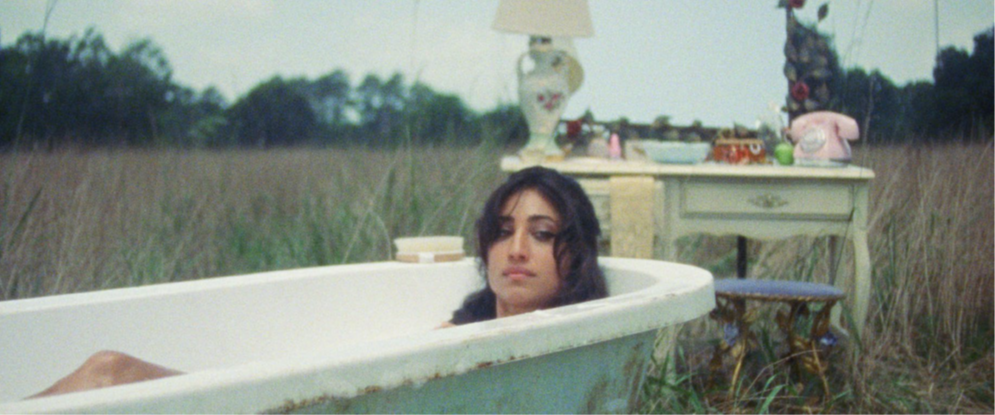
Annapurna Sriram’s Fucktoys storms cinema John-Waters style – capitalists beware!
P. Stuart Robinson (b. 1958), is an Associate Professor in Political Science at the University of Tromsø. He writes academically about the politics of film, and has published in such scholarly journals as Alphaville, Apparatus and Nordlit.
*
KVIFF 2025: Toys-R-Us! All of us! That’s just good business. But fear not, help is at hand: Annapurna Sriram’s Fucktoys cuts to the black, sex-industry heart of capitalism, lays it bare & turns it upside down. This is a glorious work of offbeat cinema – and surely a cult-classic in the making – but it’s politically important too, because this is how we fight back, comrades!
The title says it all. This is a film that screws (pardon the expression!) with our expectations and gives us something to think about. Let’s take the sexualised objectification to the limit but then, here’s the surprise. Let’s see how that really feels – especially for a woman.
And here’s another surprise: it’s not simple victimhood. Women, as well as those blessed with a certain queerness: they’re agents too. We might forget that because we don’t often see things from their perspective. That’s where Annapurna Sriram comes in. This isn’t just a movie about fucktoys. This is their movie.
The story of the beleaguered heroine AP is a quintessential woman’s story but it’s also Everyman’s, read as every human’s. In a sense women are on the front line of class struggle. Their battle is ours – or should be. They are the shock troops, dangerously close to cannon fodder, fighting fire with fire – if fire is a metaphor for sexual power.

The struggle remains a broader one, as exemplified by the filmmaker herself, not just as a woman of ‘colour’ but also a human of her time – the Age of Precarity – a millennial, used to dealing with poor prospects on every front. She doesn’t hesitate to put this in context: ‘We are living through this curse of late-stage capitalism.’ And more! There’s a new ‘structure of oppression’ at every turn if the cards are really stacked against you – and we soon discover, in AP’s case, they most certainly are…
From the first shot we know we’re a long way from home (Dorothy)! The mise-en-scène is as exquisite as it is fleeting, like the sleek unfolding of a Disney animation. All is lush, tropical and liquid – figuratively and literally. The Little Mermaid wouldn’t be out of place here, except this is a little earthier. Are we in the backwaters of Kerala, India, perhaps, or the Mississippi Delta, USA…?
We gravitate gently, like a floating lily-pad, to the pontoon where the petite AP and her larger-than-life fortune-teller, played with campy, caged bad-ass brilliance by Big Freedia, are communing. At this point, I’m picking up a distinctly Caribbean vibe. We are evidently everywhere and nowhere and yet, as we will soon discover, we are most certainly in Greater Trashtown. I take this as a symbol of what capitalism produces (above all) and where it has left us.
It’s part urban wasteland, part jumble-sale paradise. Like Terry Gilliam’s Brazil (1985), it’s ‘somewhere in the 20th century’ or, implicitly, beyond – one of those dark, otherworldly places where we can observe The Future unfolding. As dystopias go, Trashtown just happens to be unusually upbeat and fun packed.

‘You been getting mixed up in some bad juju or what?’ says the mistress of the tarot. The authoritative voice – and presence – of the soothsayer, and the mesmerising shuffle and dance of the cards and their images, lend the scene a mythic quality, an air of cosmic anticipation.
Never underestimate the power of still images in movement. This is the beating heart of cinema – its dissection, its celebration. Seconds in, the audience is already accustomed to the movie’s unique world and the idea that here strange things can and probably will happen.
The fortune-teller reveals with comic brutality that her client is under a curse and that it will, of course, be extravagantly expensive to remove. It will also require the ritual sacrifice of an innocent lamb. Our protagonist receives the bad news with a sense of inevitability. After all, she might have guessed, the way things had been going!
Once she stops crying, she accepts her fate and her challenge like a latter-day Candide, with wide-eyed naivety and fortitude. The reassuring words of the fortune-teller help buoy her spirits, ‘It’s no biggie, baby. It’s just a curse!’ Nevertheless, the image of lambs to the slaughter looms large henceforth…

So, on your bike – or very cute scooter – for AP rides a Vespa everywhere! Or is it a cheap knockoff? The imagery and style are at any rate reminiscent of Bollywood and yet also just about every 70s Italian film you never saw. She’s world-cinema’s Audrey Hepburn on some kind of nightmare-flashback Roman Holiday. There’s an air of romance, certainly, but here’s the irony: there’s work to be done, sex-work to be precise, if the cost of an uncursing is ever going to be raised. AP turns out to be a candidate for the most sexually savvy ingenue in cinema history.
Her story is a kind of parable. She faces a curse on multiple levels: it’s personal, it’s gendered, it’s racial. It’s the destiny of the oppressed everywhere. Her impossible quest to be rid of the curse confounds all tonal registers. It is gritty, melancholy, and tremendous fun in equal measures. Ultimately it provides a disturbing yet profoundly uplifting song for our hearts. Fighting the power means embracing the joy – not least the joy of sex. Money in a way is the curse, and the only solution is more money. AP needs some fast and what are her options…? Well, in essence at least, this is a joyful thing, albeit tarnished by the need to be a little transactional…
Here lies the ambivalence and the sexual politics at the heart of the movie. AP and her marginal-misfit associates live and breathe the love in the face of its continual asphyxiation by the logic of pure, objectifying materialism, the cynical, privileged appropriation of what human beings are judged to have to offer. This inevitably entails their dehumanisation, perhaps even their annihilation.
It’s Hobson’s choice: you can try to be someone, and be objectified as well as vilified, or you can disappear, be nobody, a faceless drone in the service of the new aristocracy. The waiter at the spectacular orgy, laid on for those sufficiently rich and debauched, poses this as a question for the protagonist, ‘What do you think is worse: to be a whore or to be invisible?’

A great filmmaker doesn’t have to be a megalomaniac, but I suspect it helps. I must confess I presumed Sriram to be just such a burning control-freak until I got a proper reality-check. I met the woman herself, first in the hallway after one of her late-night screenings. She just hung out there to greet anyone who felt like staying to talk about the film.
It seemed so natural it made me wonder why I’ve never seen another director do the same. She’s not exactly stuck up! The positive impression was confirmed by our slightly more formal interview a couple of days later. I learned that some really do have greatness thrust upon them. Necessity and struggle set the scene for this production.
The shoestring budget meant Sriram had to do just about everything herself. And did she ever rise to the occasion! The writing, directing and acting are all top-drawer. Moreover, the crisp, stylish production does the filmic raw material, in good old 16mm, enormous credit. This does not scream low budget by any means. Rather, it screams, ‘Welcome to Alt Hollywood! We can do anything better than you, and at a fraction of the cost. How do you like them apples, captains of industry, moguls of movieland?
Sriram told me she recently met that icon of alt cinema and all things camp, John Waters, who came to a screening and told her he really liked her film. I don’t doubt it for a minute, and not only because the film is that good. Meeting Sriram in person confirmed for me that she is, above all, honest – disarmingly so. And here’s the paradox of a movie set in an adults-only Neverland, the authenticity shines through, the fairytale never stops being real.

This is the best kind of cinematic realism, the emotional, human – and occasionally magical – variety. The lap of luxury is real too, and there’s one lurking in Trashtown’s most exclusive enclave. It’s where the fantasies of some, the privileged, can be made concrete. Here everything is perfect, as God and Money intended. Better still, AP and her dream-ticket, dreamboat client are on the sprawling, pristine bed together.
Something’s wrong all the same. We don’t see the problem, which has regrettably arisen (wrong word), but we know almost immediately what it is, as a supremely awkward and instantly recognisable moment between two human beings is captured. They are neither hustler nor criminal psychopath in this exquisite cinematic moment. They are just two frail souls cast adrift in their arbitrary corporeal trappings, whose best laid plans may simply collapse as suddenly and inexplicably as any dysfunctional erection.
The filmmaker drew on her own experiences and found a way to do them justice but also to reframe them in powerful, cinematic terms. As she puts it, ‘The seeds are all truthful but then I want to put it in a heightened theatrical fairytale.’ This is a film that says, ‘Wake up from the nightmare of history’ and start dreaming with your eyes wide open!
The language of love and lust are the same – why wouldn’t they be? Words lose their meaning, however, when the trappings of love are stripped away and even replaced with disdain or hatred. This is illustrated beautifully by the film’s denouement, as our star-crossed heroine encounters a sort of arch-villain for our times, a character lent an exquisitely subtle malevolence by the performance of François Arnaud. He is the beautiful white male, the complacent, facile embodiment of power and nihilism. Her tenderness is his craving. Her love is his merciless greed.
‘I love you,’ she says.
‘I love you!’ he replies, ‘I love that you’re not some basic white bitch – fucking love that!’

If you’re lucky enough to see this film, don’t let the fun fool you into thinking it’s not a serious movie. Fucktoys is a highly articulate statement in the glorious language of cinema. Consider, for example, the high craft and wit embodied in the attention to detail, that we might spy a wanted poster for AP’s ‘accomplice’ Danni (lent a preternatural poise in the face of all setbacks by Sadie Scott’s brilliant performance) for ‘assaulting a celebrity’ and other niche crimes.
Then there’s the rich referentiality: the Hazmat suits for the ubiquitous cleaners of filthy Trashtown, for example, recall the nightshift workers (and renegades) of Terry Gilliam’s Brazil (1985). These formal merits are not empty gestures either. The film actually has something to say.
This ‘female-gaze sexploitation movie.’ as Sriram herself calls it, doesn’t bang you over the head with its message, but it doesn’t bury it in a lugubrious arthouse riddle either. Here’s the point, as I read it: We have to make our own sexpots, do our own thing, with gay abandon. Above all, we have to take back the love – and that means taking back the lust too. Take it all, from high romance to the queerest of kinks, and make it ours! This is the message of Fucktoys: We’re in this together. Make love, not trash, unless it’s beautiful, of course…
‘I love trash,’ says the self-styled art connoisseur with money to burn. ‘Then you’re going to love me,’ replies AP. Herein lies the essence of postmodern resistance. Trash really can be beautiful if we make that ours too. Just ask John Waters – or Annapurna Sriram!